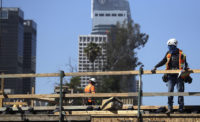A spate of recent high-profile highway work zone crashes has yet to translate into safer conditions for construction workers, according to an Associated General Contractors national survey, released May 23.
Nearly half of the highway contractors that participated in the annual survey, initiated in 2015 and conducted from April to May, feel that the risk of work zone crashes is greater now than it was a year ago. A similar percentage consider the risks unchanged and only 3% say conditions have improved. And 64% of 514 complete responses to the survey—sent to 5,000 highway and utility member firms and some of their clients—had experienced at least one incident of a motor vehicle crashing into their work zones during the last year.
While survey respondents blame speeding and cell phone-related distractions for the continued hazardous conditions, they also feel states have fallen short in taking corrective measures, such as increasing fines for moving violations in construction work zones.
“Too few drivers see the need to slow down and pay attention in work zones because too few states have made work zone safety a top priority,” Jeffrey Shoaf, AGC’s CEO, said at a May 23 briefing.
Construction workers aren’t the only ones at risk, Shoaf added. Among the respondents who reported experiencing work zone crashes in the last year, 29% experienced a crash that resulted in injury to construction workers, but 66% experienced a crash in which drivers or passengers were injured.
The percentage of reported work-zone crashes involving fatalities involving drivers and passengers was nearly three times greater than those in which construction workers were killed, the survey found.
AGC says there were 700 respondents to the survey, but the number of complete responses was 514. In addition, "unsure" replies to a question were eliminated from the analysis.
Increased law enforcement, either through greater police presence or ticketing through the use of automated speed cameras, and higher fines would go a long way toward making work zones safer, respondents said, as would closing roads and detouring traffic.
Yet more work is needed. While the 2021 Infrastructure Investment and Jobs Act now requires states to implement programs to protect vulnerable road users, such efforts typically focus on pedestrians and cyclists, Steve McGough, president and CEO of construction software developer HCSS, which conducted the study with AGC, said at the briefing.
“They forget workers are part of that community,” McGough said.
Though several states also have taken steps such as to incorporate work zone awareness in their new driver education programs, none appear to have gone as far as Maryland. Within weeks of a March 2023 incident in Baltimore that killed six construction workers, a 27-member multidisciplinary work group was formed to examine ways to improve work zone safety for both workers and motorists.
The work group crafted 15 regulatory and operational recommendations in education, engineering, and enforcement, many of which have already been implemented. The group was led by Lt. Gov. Aruna Miller, herself a former transportation engineer, who won an ENR Top 25 Newsmaker award for her efforts.
AGC has made its own contribution to the awareness effort, releasing two new public service videos urging drivers to be more careful in work zones.
McGough noted that because new funding has increased the number of highway construction projects underway, the risks to workers are likely to increase as the advent of summer puts more motorists on the road. He urged public officials to make work zone safety “as much a priority as driving sober and buckling up.”



Post a comment to this article
Report Abusive Comment